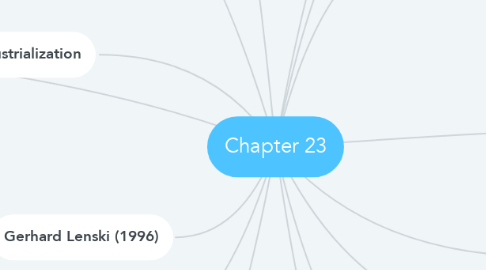Chapter 23
by Joseph Huebner


1. Industrialization
1.1. Began in Europe around 1750's, but it happened beforehand with some inventions like the knitting machine.
1.2. Was caused by demand for upkeep for supplies at home, and abroad.
1.3. Income increased, until people started looking for work in low income areas for cheaper.
1.4. By the 1900s many factories had worker regulations, and living standards grew.
2. Gerhard Lenski (1996)
2.1. Argued social equality tends to increase in advanced industrial societies.
3. Wealth Distrubution
3.1. Huge wealth differences between the top 5 percent, and the bottom quin-tiles.
3.2. The income for the wealthy dropped 36 percent during the great depression, and rebounded 36 percent.
4. Environmental risks on American Periphery
4.1. First example is Flint Michigan's water supply when they switched to a cheaper water source in 2014.
4.2. Four months after the switch families started to take notice of the huge change.
4.3. The new source of water corroded the water supply.
4.4. Low income neighborhoods have been studied to place hazardous environmental projects.
5. Colonialism
5.1. Complete politiacl, social, economic, and cultural domination of a terrority and people.
5.2. Colonial power maintains dominance in the territory.
5.3. The British Empire had a huge part of colonialism.
5.3.1. By 1815 Britain had gain control of Dutch South Africa.
5.3.1.1. By 1819 Singapore one of the Britain's rivals extended their hand for help in trade.
5.3.2. They covered the maximum extent around 1914 when it covered a fifth of the worlds land surfaces and a fourth of the population.
5.3.3. After WW2 it started to fall apart.
6. Imperalism
6.1. Using rules and policies of another nation or empire and taking over another foreign nation and holding on to them.
6.2. In the 1900s Europoean buisness interests found markets overseas.
6.2.1. These markets led to imperialism in Africa, Asia, and Oceania.
7. Postcolonial studies
7.1. Postcolonial studies are the studies of the past and prescient interactions between European nations and the societies they colonized.
7.2. Also used to describe the second half of the 20th century.
7.3. Used as a loose term, but has been growing and actively enacting a wide range of investigation of power relations.
8. All countries belong to larger global system.
9. They all have different power.
9.1. This power ranges from three different types
9.2. Economic
9.3. Semi periphery and periphery.
9.4. Core
10. Core
10.1. Strongest most powerful nations that have the most productive economies
11. Semiperphery
11.1. Produce and export industrial goods and comomdities but lack power.
12. Neoliberialism
12.1. Neo-liberialism is the current form of the classic economic liberalism laid out in Adam Smith's manifesto.
12.1.1. He argued free trade was the best way to keep a country going, rather than having government assistance.
12.2. It prevailed until the 1930's when Theodore Roosevelt's New Deal came in.
12.2.1. Was used to have the government and banks increase employment. The government should promote the common good.
